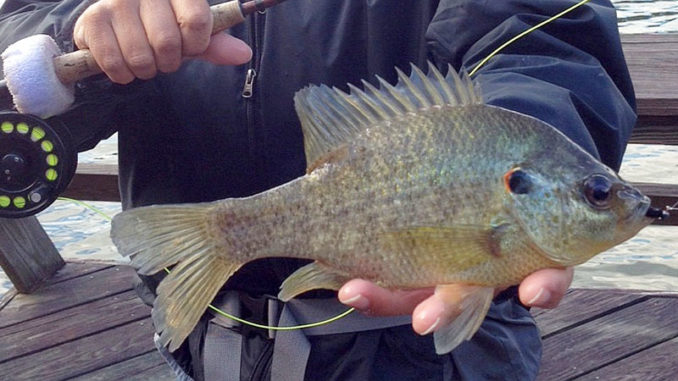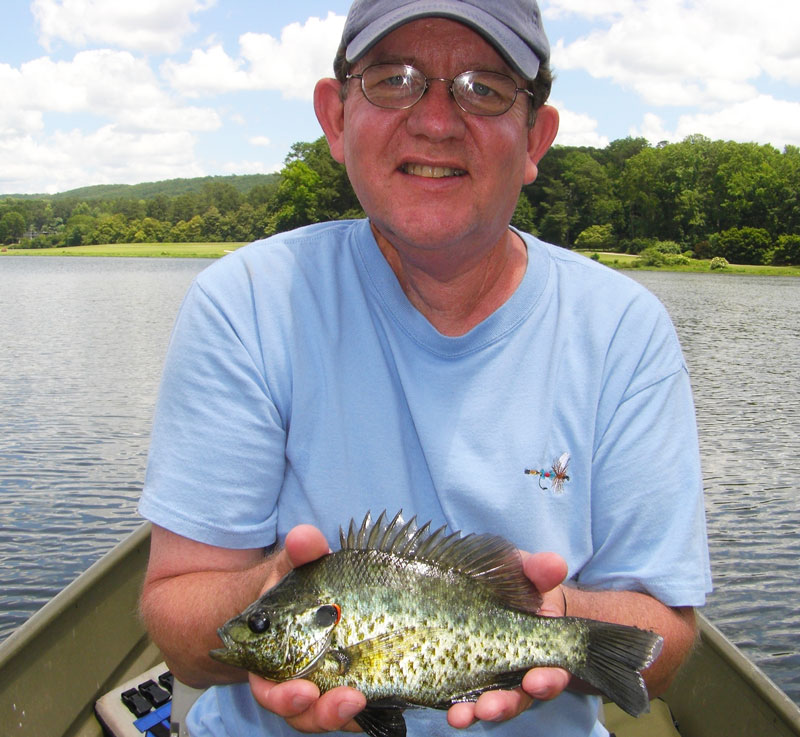
Sitting inside J & H Restaurant in the small town of Chatham for a late lunch, my mind wandered back to the transpirations of that morning.
I had made an early morning drive to nearby Caney Lake in hopes of catching a redear at least 11 inches or longer. During spawning season – late February through March – a female this size will break the one-pound mark.
My goal was to displace the long-standing state fly rod record of 0.88 pounds held by Joe Bourgeois. No offense to anyone, but that’s a record destined to be broken.
While I’ve caught many redears a pound or more on fly, records of any kind have never been a consideration. I just love catching these feisty sunfish. When you hook one 8 inches or more on a 4-weight rod, it’s like fighting a wet cat!
Why Caney holds king crackers
When it comes to readers – a.k.a. chinquapins, a.k.a. shellcrackers – there’s no better place to catch a monster than Caney Lake. On the conventional tackle state fish records, this 5,000-acre Jackson Parish reservoir holds eight of the top 10 spots, including the state record of 2.87 pounds.
What makes Caney so special? Water quality.
Back in my limnology class in college, we learned that two of the major factors in aquatic food production are alkalinity and hardness. High alkalinity waters have a significantly higher production of aquatic insects and crustaceans than low alkalinity waters.

While Caney isn’t a high alkaline water, it’s higher than the vast majority of lakes in Louisiana.
In addition, the lake’s deep, clear waters, grass beds, and gravel substrate provide optimum feeding, holding and spawning areas for crackers.
Selecting the right fly
The night before this trip, I had tied up a bunch of Rosborough-style Hares Ears in gray and brown. This is a very buggy variation of the standard beadhead Hares Ear fly.
The RSHE imitates a variety of aquatic insects, but it can also resemble small snails.
When chinquapin get to about 6 inches in size, their diet changes from mostly insect larvae (craneflies, midges) to minnows, mussels, and snails. It’s this diet that accelerates their growth.
For example, Lake Havasu in Arizona is full of zebra mussels. It’s also full of trophy crackers – many over 3 pounds, including the world record of 5.75 pounds!
A second rod is always at hand. Tied on the leader of that rod is either a Cap Spider or Fluff Butt, which imitate crustaceans and minnows, respectively. Both jighead-style flies that can get deep.
The flies that catch redears also catch bass, crappie, catfish, and drum (goo). In fact, the two world records I’ve set for fly-caught drum were taken on Cap Spider. For this reason, I never use less than a 4-weight rod.
When the going gets tough
Just my luck, a strong cold front had passed through the night before. Like their bluegill cousins, chinks will move from a bed into deeper water on high pressure days.
Since redear spawn fairly deep – 3 to 5 feet of water – the impact isn’t as great. A few beds still held fish.

To compensate, I attached a tiny strike indicator about four feet above the RSHE. Making a somewhat-open loop cast to avoid entanglement, I then let the fly sink down before making a small twitch every few seconds.
On this day, the wind and ripples aided my cause. The float drifted the fly just enough to cover the swath of bedding area. The ripples induced a vertical motion that triggered bites. Action was slow but consistent.
The grass is greener
After pulling out a couple dozen decent chinks (roughly 8 inches), the action died. So I moved to another favored habitat – the edge of submerged grass beds.
At one time, Caney was devoid of hydrilla due to an overstocking of grass carp. But the grass is back, and the redears love it!
Whenever I spot a large number of minnows swimming on the surface, I go the Fluff Butt. This is the best minnow imitation, by far. Sure enough, when I came onto a school, the Butt kicked redear butt!
Despite catching good numbers of nice fish, there were no monsters this day. The largest was right at 10 inches. By the time it was caught, I already had my “Cormier Limit” of 30 in the bag. So it enjoyed sweet freedom!
I’ll be making another couple of runs to Caney this spring. Records aside, there’s too much fun in catching chunky chinks!
Fishing forecast
If you love sightcasting to redfish, March can be one of the best months of the year – when the wind cooperates!
Over the next few weeks marsh grass will spread out and thicken, attracting loads of juvenile shrimp, small crabs and baitfish. It also filters out the water and maintains clarity. But it also presents challenges for fly presentation.
My favorite choices for grass are Ron Ratliff’s Fiddle Sticks Crab, and bendback style flies like the Prince of Tides and Bendback Mullet. On calm, overcast days, tossing small poppers will be as fun as the law allows!
Throughout the month, bass will be spawning. In grassy marsh areas like Delacroix and Lacassine, poppers, jerkshad flies like the Smallmouth Slider, and Seaducers will garner strikes. In the deeper lakes, try weighted flies like Bass Bullies, Y2K Buggers, and Kray Phish.
As mentioned, redears will be bedding this month in slightly deep water. Weighted flies like the Cap Spider, Fluff Butt, or Cajun Tickler are great options. Let the fly get to the bottom, then strip in very slowly.
Crappie action remains good this month. Cast Crappie Candies and Fluff Butts along cypress trees, submerged logs, and around boat docks.
What’s happening
- Mar. 2 (Sat) – Red Stick Day fly festival, Waddill Outdoor Education Center, 4142 Flannery Rd, Baton Rouge. 8:30 a.m. to 3:30 p.m. Free admission. Seminars, fly tying, casting, kayak demos, fishing, raffles and more. Sponsored by Red Stick Fly Fishers, website www.rsff.org.
- Mar. 16 (Sat) – Orvis Fly Fishing 101, 7601 Bluebonnet Blvd, Baton Rouge. 8 a.m. to 10:30 a.m. Free clinic covering the basics of tackle and rigging, with hands-on fly casting. Class size limited, so registration required. Other dates available. For more info, call 225-757-7286.
- Mar.23-24 (Sat-Sun) – Texas Fly Fishing and Brew Festival, Plano Center, Plano, Tex. Exhibitors, seminars, casting clinics, microbrew samplings, film festival and more. Over a dozen nationally-renown speakers including Ed Jaworoski, Dave Whitlock and Blaine Chocklett. Website: www.txflyfishingfestival.org
- Mar. 30 (Sat) – New Orleans City Park Big Bass Fishing Rodeo & Fishtival. Registration: 6 a.m. to 8:30 a.m. at Parkview Café. Fishing begins 6:30 a.m. Weigh-in at 11 a.m. Entry fee: $10 adults, $5 kids (12 & under). Eight categories including include Fly Rod Bass and Fly Rod Cichlid. Website: www.neworleanscitypark.com.
- Mar. 30 (Sat) – Cenla Fly Fishing 101, Booker-Fowler Hatchery, 10 Joan Stokes Road, Forest Hill. 8:30 a.m. to 12:30 p.m. Free workshop covering tackle, knots and leaders, flies and hands-on casting. Pre-registration required. Hosted by Kisatchie Fly Fishers. Website: www.kisatchiefly.org.
- Apr. 6 (Sat) – New Orleans Fly Fishing Expo, Deutsches Haus, 1700 Moss St., New Orleans. 8 a.m. to 4 p.m. Free admission. Seminars, fly tying, casting, exhibitors and more. Special guest: John Cave. Website www.neworleansflyfishers.com.